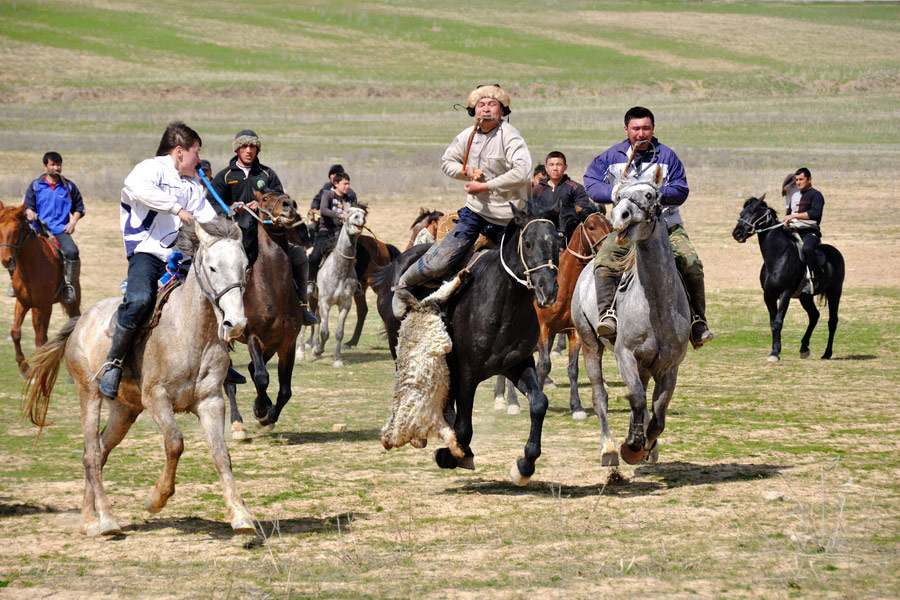 Buzkashi
Buzkashi
Tajik sports and games are a fun and truly spectacular aspect of local culture. Today, the most popular sports are the equestrian games buzkashi and chavgonbozi and a wrestling match known as gushtingiri. So popular are these competitions that even a “small” local tournament can attract several thousand spectators.
Tajik wrestling can be seen at local championships and at festivals, holidays and even weddings, while traditional equestrian games are almost exclusively played at specially arranged competitions.
Buzkashi
Buzkashi is an equestrian game which has been popular across Central Asian for many centuries and is often played at local and international tournaments. In each country the game has a different name: in Kazakhstan it is called kokpar, in Uzbekistan kupkari, in Russia kozlodranie and in Tajikistan buzkashi.
The game is based on a fight between riders for the carcass of a ram or a goat. In the past, up to a thousand players would take part in the game at the same time! Gradually, new rules were formed and now only two teams of four people compete in buzkashi at a time.
The game takes place on a field measuring 400x30 meters, on either side of which is a net. The goal of each team is to lift the carcass (ulak) and throw it into their own net. This is no easy task, as the carcass usually weighs at least 40 kilograms and must be snatched up while galloping on horseback. During the fifteen-minute game, each team tries to score more points than their opponent. In the fight for the carcass, certain rules must be followed: A player cannot push the ulak off his opponent’s horse or grab it off the back of his opponent, while the one who seizes the carcass is not allowed to tie it to his saddle.
In official games, riders can only use a whip (kamcha) on their own horse, but in amateur games it may also be used on the opponents’ horses and even on the opponents themselves. While this certainly adds an element of cruelty to buzkashi, it has nonetheless been a part of entertainment in the region for centuries.
Chawgonbozi
Chawgonbozi is an old Tajik equestrian game which is better known in other countries as equestrian polo. The game was popular in historic Persia and Central Asia and only became famous worldwide after the British learned it in India in the 19th century and spread it abroad. Some of the technical details in chawgonbozi and polo differ, but the general principle of the game is the same: two teams of riders try to score the ball into their opponent's goal with long wooden clubs.
Chawgonbozi is played on a field of 200x120 meters, while polo is played on a field of 275x145 meters. The team consists of 6 people in chawgonbozi and 4 in polo, and the ball made of wood in the former and bamboo or plastic in the latter. Thanks to the smaller field and extra players, chawgonbozi is a dynamic and highly competitive game. Riders must be confident in the saddle, agile and resilient in collisions.
Medieval chronicles detail how Tajiks from the Khuf River Valley in the Pamir Mountains were once famous far beyond their borders for their chavgonbozi skills and for playing two different versions of the game: one on horseback called guybecht and one on foot called putbecht.
Gushtingiri
Gushtingiri is an ancient Tajik wrestling match which highly resembles other types of martial arts in Central Asia. Wrestlers wear robes and belts and can grab and throw their opponent using this clothing. Victory is declared to the first wrestler to throw his opponent onto his back. In gushtingiri, even touching the mat with one foot is viewed as a defeat. The fight can last for a maximum of 10 minutes but usually ends much faster, since the wrestlers are skilled at using various tricks to ensure victory.
Today, Tajik wrestling remains wildly popular, with both demonstration fights and professional tournaments held in the country. At the major competitions, children compete first, followed by amateur adults and finally professional wrestlers, who enter the arena at the height of the day. The best wrestlers are highly honoured and respectfully referred to as polvon, or hero.
Tajik sports and games are energetic, heart-racing events that spectators will not soon forget!

